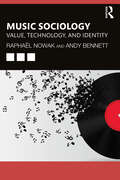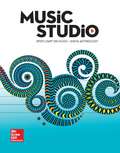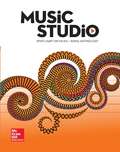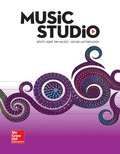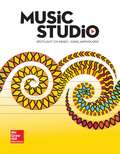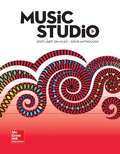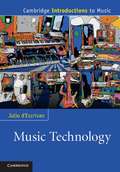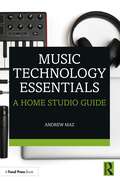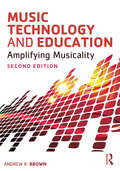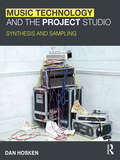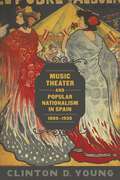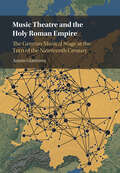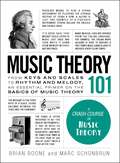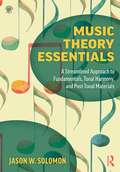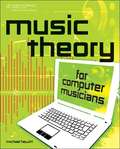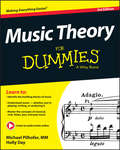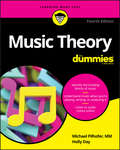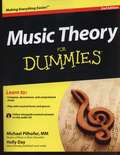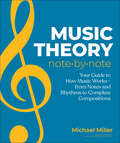- Table View
- List View
Music Since 1900: Transformations of Musical Modernism
by Julian Johnson Guldbrandsen, Erling E. and Johnson, Julian Erling E. GuldbrandsenProfound transformations in the composition, performance and reception of modernist music have taken place in recent decades. This collection brings fresh perspectives to bear upon key questions surrounding the forms that musical modernism takes today, how modern music is performed and heard, and its relationship to earlier music. In sixteen chapters, leading figures in the field and emerging scholars examine modernist music from the inside, in terms of changing practices of composition, musical materials and overarching aesthetic principles, and from the outside, in terms of the changing contextual frameworks in which musical modernism has taken place and been understood. Shaped by a 'rehearing' of modernist music, the picture that emerges redraws the map of musical modernism as a whole and presents a full-scale re-evaluation of what the modernist movement has all been about.
Music Sketches
by Friedemann SallisThe term 'music sketch' relates to the vast variety of documents that are used by composers to work out a musical technique or idea and to prepare their work for performance or publication. These documents can often provide crucial insights into authorship, biography, editorial practice and musical analysis. This Introduction provides students and scholars with the knowledge and skills they need to embark on research projects involving the study of composers' working documents. Presenting examples of the compositional process over a 400-year period, it includes a selection of detailed case studies on how sketches were created and the techniques that were used, such as transcription and the sorting of loose leaves. Numerous illustrations of manuscripts and autographs, many of which have never been published before, show how these vital documents can be used to better understand the compositional processes of the seventeenth and eighteenth centuries.
Music Sociology: Value, Technology, and Identity
by Andy Bennett Raphaël NowakMusic Sociology critically evaluates current approaches to the study of music in sociology and presents a broad overview of how music is positioned and represented in existing sociological scholarship. It then goes on to offer a new framework for approaching the sociology of music, taking music itself as a starting point, and considering what music sociology can learn from related disciplines such as critical musicology, ethnomusicology, and cultural studies. As a central form of leisure, consumption, and cultural production, music has attracted significant attention from sociologists who seek to understand its deeper socio-cultural meaning. With case studies that address sound environments, consumption, media technologies, local scenes, music heritage, and ageing, the authors highlight the distinctive nature of musical experience, and show how sociology can illuminate it. Providing both a survey of existing perspectives the sociology of music, and a thought-provoking discussion of how the field can move forward, this concise and accessible book will be a vital reading for anyone teaching or studying music from a sociological standpoint.
Music Studies and Its Moment of Truth: CMS Emerging Fields in Music (CMS Emerging Fields in Music)
by Edward SarathMusic Studies and Its Moment of Truth: Leading Change through America’s Black Music Roots presents a new framework for racial justice discourse in the context of music studies and education. Centering on Black American Music, the book issues challenges to both the conventional music studies paradigm and decades-old reform efforts. While Black American Music ranks high among America’s contributions to world culture, and offers musicians powerful tools for musical practice and understanding, this musical legacy remains remarkably marginalized even in activist conversations. The author argues that this reflects lingering and unexamined racist patterns that persist even among the most fervent voices for anti-racist interventions, and addresses the need for a higher-order activist framework within music studies. Delving further into the transformative changes needed to pursue racial justice, the short pieces collected in this book discuss topics including a shift from multicultural ideology to a transcultural model of musical pluralism, analysis of the multi-tiered nature of musical racism, the whitewashing of music studies activism, K-12 music teacher education as the locus for paradigmatic change and the potential for a transformed model of music studies to catalyze an overarching revolution in creativity and consciousness in both education and society at large. Critiquing the failures of progressive reform efforts and conventional reaction, this book argues that major changes are needed to the discourse on racism in music studies, and envisions new paradigms for the future.
Music Studies and Its Moment of Truth: CMS Emerging Fields in Music (CMS Emerging Fields in Music)
by Edward SarathMusic Studies and Its Moment of Truth: Leading Change through America’s Black Music Roots presents a new framework for racial justice discourse in the context of music studies and education. Centering on Black American Music, the book issues challenges to both the conventional music studies paradigm and decades-old reform efforts.While Black American Music ranks high among America’s contributions to world culture, and offers musicians powerful tools for musical practice and understanding, this musical legacy remains remarkably marginalized even in activist conversations. The author argues that this reflects lingering and unexamined racist patterns that persist even among the most fervent voices for anti-racist interventions, and addresses the need for a higher-order activist framework within music studies.Delving further into the transformative changes needed to pursue racial justice, the short pieces collected in this book discuss topics including a shift from multicultural ideology to a transcultural model of musical pluralism, analysis of the multi-tiered nature of musical racism, the whitewashing of music studies activism, K-12 music teacher education as the locus for paradigmatic change and the potential for a transformed model of music studies to catalyze an overarching revolution in creativity and consciousness in both education and society at large. Critiquing the failures of progressive reform efforts and conventional reaction, this book argues that major changes are needed to the discourse on racism in music studies, and envisions new paradigms for the future.
Music Studio: Spotlight On Music [Grade 2], Song Anthology (General Music Ser.)
by Judy Bond Margaret Campbelle-Holman René BoyerNIMAC-sourced textbook
Music Studio: Spotlight On Music [Grade 3], Song Anthology (General Music Ser.)
by Judy Bond Margaret Campbelle-Holman René BoyerNIMAC-sourced textbook
Music Studio: Spotlight On Music [Grade 5], Song Anthology (General Music Ser.)
by Judy Bond Margaret Campbelle-Holman René BoyerNIMAC-sourced textbook
Music Studio: Spotlight On Music [Grade K], Song Anthology (General Music Ser.)
by Judy Bond Margaret Campbelle-Holman René BoyerNIMAC-sourced textbook
Music Studio: Spotlight on Music [Grade 1], Song Anthology (General Music Ser.)
by Judy Bond Margaret Campbelle-Holman René BoyerNIMAC-sourced textbook
Music Studio: Spotlight on Music [Grade 4], Song Anthology (General Music Ser.)
by Judy Bond Margaret Campbelle-Holman René BoyerNIMAC-sourced textbook
Music Teachers' Values and Beliefs
by Rachael DwyerIn Music Teachers' Values and Beliefs, Dwyer investigates the relationships between teachers, learners and music in music classrooms. Using Bourdieu's concepts of habitus and doxa as an interpretive lens, the book explores the values and beliefs of four music teachers, depicted in richly detailed narratives. The narratives are contextualised through the examination of traditions of music and contemporary approaches. In the past, music education has been shaped by elitist tendencies regarding the types of music worthy of study, the ways in which music should be learnt, and the purpose of such learning. Contemporary approaches to music education have enacted significant change in some regions and systems, while others have been slower to leave behind deeply entrenched values, beliefs and practices. These approaches have been blamed for low rates of participation and engagement in school music education, despite the fact that the majority of young people listen to and enjoy music outside of school. This innovative book provides music education researchers and practitioners with a new understanding of the impact of teachers' personal values, beliefs and experiences of music and music education on classroom practice, and the impact this has on students' experiences of music education.
Music Technology
by Julio D'EscrivánEmphasising the creative aspect of music technology, this introduction sets out an overview of the field for music students in a non-scientific and straightforward way. Engaging and user-friendly, the book covers studio concepts: basic audio and the studio workflow, including audio and MIDI recording. It explores synthesisers, samplers and drum machines as well as basic concepts for electronic performance. In considering the role of the DJ, the book addresses remixing and production, drawing upon many examples from the popular music repertoire as well as looking at the studio as an experimental laboratory. The creative workflow involved in music for media is discussed, as well as controllers for performance and the basics of hacking electronics for music. The book as a whole reflects the many exciting areas found today in music technology and aims to set aspiring musicians off on a journey of discovery in electronic music.
Music Technology Essentials: A Home Studio Guide
by Andrew MazMusic Technology Essentials provides an overview of the vocabulary, techniques, concepts, and devices used in contemporary music production and guides readers through the essential fundamentals of music technology so that they can create their own music productions at home. This highly accessible book covers sound fundamentals and theory, as well as practical topics like hardware, software, MIDI, digital audio, synthesis, computer notation, and audio-visual applications, to equip the reader with the principles they need to achieve professional-sounding results. Each chapter is accompanied by real-life examples and exercises that can be applied to any digital audio workstation software, to put the lessons into practice. This book will also help readers evaluate their requirements for home music production while working within a sensible budget. Music Technology Essentials is the ideal textbook for beginners inside and outside of the classroom, including those on music and music production courses, who wish to enter the world of music technology but are unsure where to start or what to purchase.
Music Technology and Education: Amplifying Musicality
by Andrew BrownMusic Technology in Education lays out the principles of music technology and how they can be used to enhance musical teaching and learning in primary and secondary education. Previously published as Computers in Music Education, this second edition has been streamlined to focus on the needs of today’s music education student. It has been completely updated to reflect mobile technologies, social networks, rich media environments, and other technological advances. Topics include: Basic audio concepts and recording techniques Enhanced music instruction with interactive systems, web-based media platforms, social networking, and musicianship software Administration and management of technology resources Distance education and flexible learning Music Technology in Education provides a strong theoretical and philosophical framework for examining the use of technology in music education while outlining the tools and techniques for implementation in the classroom. Reflective Questions, Teaching Tips, and Suggested Tasks link technology with effective teaching practice. The companion website provides resources for deeper investigation into the topics covered in each chapter, and includes an annotated bibliography, website links, tutorials, and model projects.
Music Technology and the Project Studio: Synthesis and Sampling
by Dan HoskenMusic Technology and the Project Studio: Synthesis and Sampling provides clear explanations of synthesis and sampling techniques and how to use them effectively and creatively. Starting with analog-style synthesis as a basic model, this textbook explores in detail how messages from a MIDI controller or sequencer are used to control elements of a synthesizer to create rich, dynamic sound. Since samplers and sample players are also common in today's software, the book explores the details of sampling and the control of sampled instruments with MIDI messages. This book is not limited to any specific software and is general enough to apply to many different software instruments. Overviews of sound and digital audio provide students with a set of common concepts used throughout the text, and "Technically Speaking" sidebars offer detailed explanations of advanced technical concepts, preparing students for future studies in sound synthesis. Music Technology and the Project Studio: Synthesis and Sampling is an ideal follow-up to the author's An Introduction to Music Technology, although each book can be used independently. The Companion Website includes: Audio examples demonstrating synthesis and sampling techniques Interactive software that allows the reader to experiment with various synthesis techniques Guides relating the material in the book to various software synthesizers and samplers Links to relevant resources, examples, and software
Music Theater and Popular Nationalism in Spain, 1880-1930
by Clinton D. YoungFrom its earliest appearance in the mid-1600s, the lyric theater form of zarzuela captivated Spanish audiences with its witty writing and lively musical scores. Clinton D. Young's Music Theater and Popular Nationalism in Spain, 1880-1930 persuasively links zarzuela's celebration of Spanish history and culture to the development of concepts of nationalism and national identity at the dawn of the twentieth century. As a weak Spanish government focused its energy on preventing a recurrence of mid-nineteenth-century political upheavals, the project of articulating a national identity occurred at the popular level, particularly in cultural venues such as the theater. Zarzuela suited this aim well, depicting the lives of everyday citizens amid the rapidly changing norms brought about by industrialization and urbanization. It also integrated regional differences into a unified vision of Spanish national identity: a zarzuela performance set in Madrid could incorporate forms of music and folk dancing native to areas of the country as far distant as Andalucía and Catalonia. A true "music of the people" (música popular), zarzuela offered its audiences an image of what a more modern Spain might look like. Zarzuela alone could not create a unified concept of Spanish identity, particularly with competition from new forms of mass culture and the rise of the Primo de Rivera dictatorship in the 1920s. Yet, as this riveting study shows, it made an indelible contribution to popular culture and nationalism. Young's history brings to life the stories, songs, and evolving contexts of a uniquely Spanish art form.
Music Theatre and the Holy Roman Empire: The German Musical Stage at the Turn of the Nineteenth Century
by Austin GlatthornPacked full of new archival evidence that reveals the interconnected world of music theatre during the 'Classical era', this interdisciplinary study investigates its key locations, genres, music, and musicians. Austin Glatthorn explores the extent to which the Holy Roman Empire delineated, and networked a cultural entity that found expression through music for the German stage. He maps an extensive network of Central European theatres; reconstructs the repertoire they shared; and explores how print media, personal correspondence, and their dissemination shaped and regulated this music. He then investigates the development of German melodrama and examines how articulations of the Holy Roman Empire on the musical stage expressed imperial belonging. Glatthorn engages with the most recent historical interpretations of the Holy Roman Empire and offers quantitative, empirical analysis of repertoire supported by conventional close readings to illustrate a shared culture of music theatre that transcended traditional boundaries in music scholarship.
Music Theory 101: From keys and scales to rhythm and melody, an essential primer on the basics of music theory (Adams 101 Series)
by Marc Schonbrun Brian BooneLearn the basics of music theory in this comprehensive and easy-to-understand guide.From classical to hard rock, and jazz to hip hop, music is constantly evolving, but many of the basics have stayed the same. Understanding these basics is key to becoming a successful musician and well-rounded music lover. Music Theory 101 covers everything novice musicians and lifelong learners need to know, including: -How to read sheet music -Understanding the construction of chords and scales -The different rhythm and time signatures -How keys are identified and organized Full of music trivia, music history, comprehensive instruction, and visual aids of scales, music symbols, and chords throughout, Music Theory 101 is the essential guide you need for a crash course in music theory that even professional musicians would envy.
Music Theory Essentials: A Streamlined Approach to Fundamentals, Tonal Harmony, and Post-Tonal Materials
by Jason W. SolomonMusic Theory Essentials offers an antidote to music theory textbooks that are overly long and dense. Focusing on the essentials, this text provides a clear-cut guide to the key concepts of music theory. Beginning with no assumptions about music theory knowledge, the book covers the core elements of music fundamentals, diatonic and chromatic harmony, post-tonal theory, and popular music in a single concise volume. Emphasizing critical thinking skills, this book guides students through conceptualizing musical concepts and mastering analytic techniques. Each chapter concludes with a selection of applications designed to enhance engagement: Exercises allow students to apply and practice the skills and techniques addressed in the chapter. Brain Teasers challenge students to expand their musical understanding by thinking outside the box. Exploring Music offers strategies for students to apply learned concepts to the music they are currently learning or listening to. Thinking Critically encourages students to think more deeply about music by solving problems and identifying and challenging assumptions. A companion website provides answers to book exercises, additional downloadable exercises, and audio examples. Straightforward and streamlined, Music Theory Essentials is a truly concise yet comprehensive introduction to music theory that is accessible to students of all backgrounds.
Music Theory For Computer Musicians
by Michael HewittMany DJs, gigging musicians, and electronic music producers understand how to play their instruments or make music on the computer, but they lack the basic knowledge of music theory needed to take their music-making to the next level and compose truly professional tracks. Beneath all the enormously different styles of modern electronic music lie certain fundamentals of the musical language that are exactly the same no matter what kind of music you write. It is very important to acquire an understanding of these fundamentals if you are to develop as a musician and music producer. Put simply, you need to know what you are doing with regard to the music that you are writing. Music Theory for Computer Musicians explains these music theory fundamentals in the most simple and accessible way possible. Concepts are taught using the MIDI keyboard environment and today's computer composing and recording software. By reading this book and following the exercises contained within it, you, the aspiring music producer/computer musician, will find yourself making great progress toward understanding and using these fundamentals of the music language. The result will be a great improvement in your ability to write and produce your own original music!
Music Theory For Dummies
by Michael Pilhofer Holly DayGrasp the concepts needed to compose, deconstruct, and comprehend musicWhether you're a student of music or a music lover, Music Theory For Dummies presents you with essential information on how to read, write, and understand music, as well as helpful hints on composing, arranging, and creating original melodies, harmonies, and chords.Music Theory For Dummies gives you a friendly, unintimidating overview of the material covered in a typical college-level course and makes music theory easy to understand. It includes updated information on current teaching techniques; the newest music examples and genres; information on mastering major and minor scales, using intervals, and recognizing pitches and clefs; the lowdown on rhythms, tempo, dynamics, and navigation; how to transcribe the music you hear and transposing it to other keys; harmonizing and accompanying melodies; composing and arranging for voices and instruments; performing your own music; and much more.Audio CD includes musical excerpts played on a variety of instruments Makes learning music theory as enjoyable as it is usefulTracks to a typical college-level music theory courseDon't get discouraged by the seemingly complicated written structure of musical theory. With Music Theory For Dummies, understanding music has never been easier!CD-ROM/DVD and other supplementary materials are not included as part of the e-book file, but are available for download after purchase.
Music Theory For Dummies
by Michael Pilhofer Holly DayTune in to how music really works Whether you’re a student, a performer, or simply a fan, this book makes music theory easy, providing you with a friendly guide to the concepts, artistry, and technical mastery that underlie the production of great music. You’ll quickly become fluent in the fundamentals of knocking out beats, reading scores, and anticipating where a piece should go, giving you a deeper perspective on the works of others — and bringing an extra dimension to your own. Tracking to a typical college-level course, Music Theory For Dummies breaks difficult concepts down to manageable chunks and takes into account every aspect of musical production and appreciation — from the fundamentals of notes and scales to the complexities of expression and instrument tone color. It also examines the latest teaching techniques — all the more important as the study of music, now shown to provide cognitive and learning benefits for both children and adults, becomes more prevalent at all levels. Master major and minor scales, intervals, pitches, and clefs Understand basic notation, time signals, tempo, dynamics, and navigation Employ melodies, chords, progressions, and phrases to form music Compose harmonies and accompanying melodies for voice and instruments Wherever you want to go musically — as a writer or performer, or just as someone who wants to enjoy music to its fullest — this approachable guide gives you everything you need to hear!
Music Theory For Dummies (Second Edition)
by Michael Pilhofer Holly DayGrasp the concepts needed to compose, deconstruct, and comprehend music. Whether you're a student of music or a music lover, "Music Theory For Dummies" presents you with essential information on how to read, write, and understand music, as well as helpful hints on composing, arranging, and creating original melodies, harmonies, and chords. "Music Theory For Dummies" gives you a friendly, unintimidating overview of the material covered in a typical college-level course and makes music theory easy to understand. It includes updated information on current teaching techniques; the newest music examples and genres; information on mastering major and minor scales, using intervals, and recognizing pitches and clefs; the lowdown on rhythms, tempo, dynamics, and navigation; how to transcribe the music you hear and transposing it to other keys; harmonizing and accompanying melodies; composing and arranging for voices and instruments; performing your own music; and much more.
Music Theory Note by Note: Your Guide to How Music Works—From Notes and Rhythms to Complete Compositions
by Michael MillerTake note: You can enjoy music analysis.This concise and clear guide to simplified music theory teaches readers who play music by ear how to read musical notation by guiding them through the basics of reading and composing music to share with others.In this revised edition, renowned music author Michael Miller will help you learn:The basics of tones, including pitches, clefs, and major and minor keysThe building blocks of rhythm, including basic notation, time signatures, and tempoHow to create tunes, starting with melodies, chords, chord progressions, and phrases and formsComposing and arranging your own music, including coverage of musical genres and forms, arranging for voices and instruments, working with scores, and performing your musicThe basics of accompaniment, including transcribing, accompanying melodies, and transposing to other keysMichael will also share online ear training and transcribing exercises to help you better understand music analysis. If your goal is to learn how to read and compose music, Music Theory Note by Note will provide just what you need to become successful.

